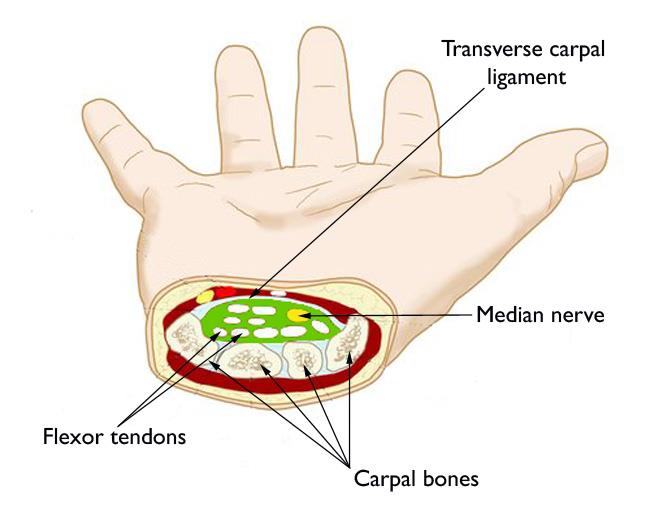Carpal Tunnel Numbness: Causes, Symptoms & Treatments
Table of Contents
- Understanding Carpal Tunnel Numbness
- What Causes Carpal Tunnel Numbness?
- Where and How You Feel Carpal Tunnel Numbness
- How to Treat Carpal Tunnel Numbness
- Key Step: Act Quickly
- Non-Surgical Treatments (Most Effective First Steps)
- Wrist Bracing (Night braces)
- Physical Therapy Massage
- Hand and Finger Exercises
- Anti-Inflammatory Medications
- Surgical Treatments (Last Resort)
- The Bottom Line
- FAQs
- About
Carpal tunnel numbness happens when the median nerve inside your wrist becomes compressed, leading to tingling, weakness, or “dead hand” sensations. This pressure usually develops from inflamed tendons caused by repetitive hand or wrist movements. Early treatment—like bracing, massage, or gentle stretching—can often relieve symptoms without surgery.
Understanding Carpal Tunnel Numbness
Carpal tunnel numbness, sometimes called
“dead hand”
or
“carpal tunnel hand,”
is one of the hallmark signs of
carpal tunnel syndrome (CTS). The medical term for these sensations—numbness, tingling, or “pins and needles”—is
paresthesia.
While it might start as mild tingling, numbness is your body’s way of warning you that something is pressing on a vital nerve in your wrist. Understanding
why
it happens and how to stop it early can help you avoid long-term damage.
What Causes Carpal Tunnel Numbness?
Carpal tunnel syndrome occurs when the
median nerve—which controls feeling and movement in your thumb and fingers—gets compressed inside the narrow space of the wrist called the carpal tunnel.
This tunnel is formed by wrist bones and a thick ligament known as the
transverse carpal ligament, which holds everything tightly in place. Inside this space are the
flexor tendons that bend your fingers and the median nerve that carries sensation to most of your hand (but not the little finger).
When those tendons become inflamed or swollen—often from repetitive motions like typing, gripping, or lifting—they push against the nerve, causing pressure. The nerve responds by sending confused signals to your brain, which you feel as pain, tingling, burning, or numbness.
Common triggers include:
- Repetitive hand or wrist movements
- Forceful or awkward gripping
- Extended wrist flexion (bending)
- Hormonal changes or fluid retention
- Conditions like diabetes, thyroid disease, or arthritis
The flexor tendons lie right next to the median nerve. Carpal tunnel numbness, pain and tingling occur because the tendons inside the canal
inflame
and
swell. In turn, the swelling squeezes down on the median nerve.
When it's crushed, the median nerve responds by sending scrambled signals to the brain. These signals are interpreted as pain, numbness, tingling -- and every other abnormal sensation due to carpal tunnel syndrome.
What causes the tendon swelling and inflammation in the first place? Nobody knows for sure. But it to be seems related to tendon stress, like
straining
your fingers repetitively and with force. That's why some doctors call carpal tunnel syndrome a
repetitive stress injury.
Where and How You Feel Carpal Tunnel Numbness
Carpal tunnel numbness can vary from person to person. It’s most often felt in the
thumb, index, and middle fingers, sometimes spreading up the forearm. The pinky finger is typically unaffected.
Common sensations include:
- Tingling or pins-and-needles
- Burning pain in the wrist or hand
- A swollen feeling (even if no swelling is visible)
- Weak
grip or dropping objects
- Numbness that wakes you at night
Early on, symptoms tend to appear at night, prompting many people to shake out their hands for relief. As the condition worsens, numbness and weakness can persist throughout the day, making simple tasks—like buttoning a shirt or typing—more difficult.
In
severe cases, the thumb muscles may shrink, and the ability to feel temperature or texture can disappear.
How to Treat Carpal Tunnel Numbness
Key Step: Act Quickly
Carpal tunnel syndrome
almost always worsens over time if untreated. Once numbness interferes with your sleep or daily routine, it’s time to act. The goal is to
relieve pressure on the median nerve—and that can often be achieved without surgery according to the
American Academy of Orthopedic Surgeons (AAOS). This is especially the case when the patient commits to several weeks of treatment.
Non-Surgical Treatments (Most Effective First Steps)
1. Wrist Bracing (Night Braces)
2. Physical Therapy Massage
3. Hand and Finger Exercises
4. Anti-Inflammatory Medications
Surgical Treatments (Last Resort)
The Bottom Line
Carpal tunnel numbness isn’t just an annoyance—it’s your body’s way of saying your median nerve is under pressure. Ignoring it can lead to permanent nerve damage and loss of hand strength.
Fortunately, most people find relief through non-surgical methods like bracing, massage, and daily exercises. The key is early, consistent treatment—the sooner you act, the faster your hands can heal and return to normal function.
FAQs
1. What does carpal tunnel numbness feel like?
It typically feels like pins and needles, tingling, or loss of feeling in your thumb and fingers. Some describe it as a “dead hand” sensation that worsens at night.
2. Can carpal tunnel numbness go away on its own?
Sometimes mild cases improve with rest and wrist support. However, most cases need consistent treatment like bracing, massage, or exercises to prevent worsening symptoms.
3. When should I see a doctor for carpal tunnel numbness?
If numbness or pain wakes you at night, lasts all day, or affects your grip strength, it’s time to get evaluated. Early treatment can often prevent the need for surgery.
About









